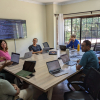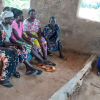Research Methodology for Identifying Social Norms that Catalyze Corruption
We believe that social norms are one of the causes of resiliency in corruption systems which is why they require more attention in anti-corruption programming. Not separate programing necessarily; rather an integrated program model that understands that classic principal-agent approaches may be required but will never be sufficient without a broadened scope to include that which drives corruption (as opposed to what enables corruption). The first step to integrate social norm change into anti-corruption programming and to make sure other programming does not inadvertently make corruption worse, is to identify the social norms at play.
We had the opportunity to test a method as part of a context analysis we were doing on corruption in the criminal justice sector in Bangui, Central Africa Republic (CAR). The purpose of this portion of the effort was to learn whether or not there were social norms that are drivers to the system of corruption. If so, whether these norms are directly or indirectly related to patterns of corrupt behaviors and whether individual attitudes about these behaviors differed from the norms.
A behavior is motivated by a social norm when the behavior is typical and approved within a group and non-compliance with this behavior would result in a negative sanction.
A Vignette Approach
The method we opted for, vignettes, was largely adapted from the CARE SNAP report (for more resources see here) and tailored to corruption and the CAR context. To identify vignettes the research team reviewed our first week of interview notes with citizens, police officers and justice officials to identify examples of typical behavior. Here is an example.
We would like to tell you a short story. Imagine Joachim is a man from Bangui. He is not a real person, just an example. Imagine the police arrested Joachim’s son for stealing bananas from the market and he is at the Police HQ. Joachim calls his cousin, Jean Paul who has an important job in the Ministry of Interior to ask him to make this go away for his son.
We then determined follow-up questions to probe the different elements of social norms:
1. What would most men in Joachim’s situation do in this situation? Here we were trying to learn what was typical behavior or the empirical expectations.
2. What would Joachim friends and family expect him to do in this situation? This question explores the notion of approved behavior or what you think others expect you to do – the normative expectations.
3. Who would be the most influential on Joachim’s decision – friends, family, community? With this inquiry, we wanted to learn about who has power and influence or in social norms language the reference group.
We then added a new fact to the vignette to explore possibilities to resist corruption and the consequences of noncompliance with expectations. But what if the cousin – Jean Paul does not want to make a call to the police.
4. How would Jean Paul’s family and friends react to Jean Paul deciding not to call the police for Joachim? This question tries to understand the social sanction involved in non-compliance with the social norm.
a. If the response showed that there is a sanction for noncompliance to Jean Paul we then asked: Are there any times where it would be okay for Jean Paul to not act? Here we were interested to see if there were exceptions to the rule.
5. Would their opinions and reactions make Jean Paul change his mind about making the call? This question seeks to understand the degree of influence the social sanction might have which helps us understand the strength of the social norm.
6. What are the disadvantages for Jean Paul calling the police? What are the advantages of Jean Paul calling the police? Drawing from the Social Norms Measurement report put out by STRIVE we added these questions to explore if there were indirect norms that also might be supporting this behavior.
Understanding the impact of gender in corruption systems has become an integrated element of our approach. So, we changed the vignette one final time; Let’s pretend, that when Joachim tried to call Jean Paul he discovered Jean Paul was in Paris. So instead he called his niece, Virginie who also worked at the Ministry of Interior. Would anything be different?
Our data collection choice
As a team with strong CAR experience, we felt strongly that a focus group was by far the best option to gather data on typical and appropriate behaviors. We expected that it would allow us to hear where there was disagreement, why and if so what nuances might matter. Given we were researching to inform program design, getting sufficiently concrete mattered. We cross-checked this assumption with our Central African advisor who has 40+ years of experience in the criminal justice sector in CAR to make sure focus groups would work in this particular sector.
Focus group worked like a charm… with citizens
We used this methodology in small focus groups with citizens from Bangui. We felt we needed to treat the topic carefully if the discussions were going to be fruitful, and more importantly ethical, because corruption is significantly connected to the recent crisis and people are understandably cautious. (Report forthcoming: subscribe to the blog to be alerted.) As such, we built in significant ‘warm-up’ time, which culminated in each person demonstrating how they would conduct a particular corrupt transaction with the facilitator. The male – female differences in tactics and approach were striking (something else we will explore more in the report). As for the vignettes, they proved to be an effective prompt to initiate concrete discussions about what is considered typical and appropriate.
Amongst our test focus groups with citizens, we had one focus group with individuals who all knew each other, and another with people who did not. Though, understandably, it took longer for the latter group to be comfortable the quality of the data derived from the vignettes was the same.
Our test with police, was not so charmed…
We were quite uncertain if a focus group with police would be possible, but after checking with people on the ground felt it was worth trying. To pilot the methodology with police officers, we asked an organization who does capacity building with the police to ask a few individuals who knew each other who they thought might be open to this conversation. Working with officers who had existing relationships and using this organization as a trusted intermediary we hoped would increase willingness to talk openly. After a relatively brief introduction we introduced our first vignette.
Let’s consider a made-up story. Imagine a man called Albert from Bangui. Imagine that his brother has been badly assaulted and the man who hit him has not yet been arrested. Albert goes to see the Chief Prosecutor – Taavi — to file a complaint and gives Taavi 2,000 CAF to accelerate the procedure. What would most men do in Taavi’s situation?
After an awkward silence, one individual in the group spoke up stating that this was impossible; Taavi could not accept the envelope. With this line drawn the sand, the rest of the group adamantly agreed. These assertions directly contradicted a week’s worth of interviews where the consensus was that everyone in the police is corrupt at every level. We were not able to break through this façade with any of our follow-up questions. In unpacking this experience, we have a few reflections on why this happened and what we could do differently.
First, we believe that the pre-existing relationships were not sufficiently strong to create an atmosphere of trust. They had been in trainings together but were from different places in the country, so did not have a strong relationship.
Second, another issue might have arisen from the style of inquiry where we asked people to speak about what ‘most men’ would do. As products of the rote learning education system in CAR, police officers may not be comfortable making such extrapolations. This, coupled with our facilitator being a white international, may have elicited them to give ‘official textbook’ responses rather than draw from real practice.
Third, the fact that police behavior is not just based on social norms, but also based on laws, rules and standard operating practices could mean that they were simply electing to answer based on one of the many drivers of decisions within their profession. So, they were not purposefully being obtuse but rather using an alternative set of rules that could/should guide behavior.
With it clear that police focus groups were a non-starter, we changed our approach and tested the vignettes at the end of individual semi-structured interviews with police. This worked better in that they answered the questions in alignment with the rest of our data, but it did not elicit rich or particularly insightful answers.
Call for Insights
We would really welcome insights into how to navigate social norm identification when the reference group exists within established structures and particularly within state institutions. If you have done this, we would really welcome learning about your methodology, what worked and how you would do it better. As always, if we get sufficient input, we will give it back to the community.
What is the Corruption, Justice and Legitimacy Project?
The Corruption, Justice, and Legitimacy (CJL) project advances systems approaches to corruption analysis in fragile and conflict-affected contexts. Focusing on the CJS, the project supports more holistic efforts to diminish corruption in core state activities related to human security. The work is built on the premise that corruption is a complex adaptive system. CJL encompasses work funded by the U.S. Department of State Bureau of International Narcotics and Law Enforcement in DRC and CAR, housed at CDA, as well as Carnegie-funded research in Uganda, housed at The Institute for Human Security at the Fletcher School. It is led by Cheyanne Scharbatke-Church and Diana Chigas, JD, Professor of Practice at The Fletcher School and Senior International Office and Associate Provost at Tufts University.
This post is part of the corruption in fragile states series.
Subscribe to our mailing list to receive future posts from experts with unique insights, points of view, and experience on anti-corruption policy, program design, and implementation.
We hope to hear and learn from your reactions to our posts. Please comment below or contact Cheyanne Scharbatke-Church, at Cheyanne Church cheyanne@besacsc.org, if you are interested in submitting a guest post.






Login or register for free to get all access to our network publications. Members can also connect and discuss with other members. Participate in our network.